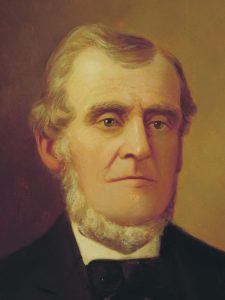Historical Context and Background of D&C 5

Video Overview
Brief Synopsis by Steven C. Harper
About a year after Martin Harris went to Pennsylvania to scribe for Joseph, he arrived there again in spring 1829. This time he said his neighbors were gathering evidence for a lawsuit and threatening to put him in jail if he did not condemn Joseph for deception. Martin said he needed to know, really know, that Joseph had plates engraved with ancient, sacred writings.1
The Lord spoke to that situation but not to Martin. In sections 4 and 6 and dozens of others, the Lord spoke through Joseph to his father or Oliver Cowdery or others. In section 5, it seems like the Lord was not on speaking terms with Martin. Rather, the Lord told Joseph that Martin’s desire for more evidence could be granted if Martin chose to meet the conditions of humility, faith, and patience.
The Lord told Joseph to remind Martin that Joseph was under covenant not to show the plates to anyone unless commanded, implying a stinging reminder to Martin, the covenant breaker who showed off the translation manuscript and lost it, contrary to his solemn promise.
The Lord told Joseph he intended to select three witnesses to testify. He would show them the plates and their witness would accompany His words to all mankind. However, the Lord made it clear that seeing is not believing.
This revelation reoriented Martin. He came to the Lord saying, “Show me and I’ll believe. And let me prove to others so they’ll believe.” With Joseph as mediator, the Lord responded that he would show Martin after he chose to believe and to be humble, not before. Martin eventually received the greater witness he sought. He became one of the three witnesses of the Book of Mormon plates and artifacts. That happened after he chose to meet the conditions the Lord set in section 5, not before.
1. “Revelation, March 1829 [D&C 5] (Historical Introduction),” p. [1], The Joseph Smith Papers, accessed July 21, 2020.
Additional Context by Casey Paul Griffiths
From Doctrine and Covenants Minute
The revelation in section 5 serves as a coda to the lost manuscript saga started with the revelation in section 3. These revelations, along with Doctrine and Covenants 10, portions of which were likely received around the same time as the revelation in section 5, all contain the Lord’s counsel concerning the lost manuscript. Joseph Smith received Doctrine and Covenants 5 in March 1829 when Martin Harris, seeking assistance and counsel, traveled from Palmyra to Joseph and Emma’s home in Harmony. Joseph and Martin had not met together since the previous summer when Joseph traveled to Palmyra only to discover that the manuscript Martin had taken was already lost. This revelation served to renew their friendship and to bolster Martin’s faith in Joseph’s work of the Restoration.
According to Lucy Mack Smith, Martin was motivated to visit Joseph partly because of a spike in opposition against the work in Palmyra, including a lawsuit threatened against Martin. One of the leaders of the opposition was Martin’s wife, Lucy Harris. Lucy Mack Smith recalled, “She [Lucy Harris] mounted her horse [and] flew through the neighborhood like a dark spirit, from house to house making diligent enquiry at every house for miles where she had the least hope of gleaning anything that would subserve her purpose, which was to prove that Joseph had not the record which he pretended to have” (Lucy Mack Smith History, 1844–1845, bk 8, 5, JSP). When the revelation was first published in 1833 in the Book of Commandments, the heading read that “Martin desired of the Lord to know whether Joseph had, in his possession, the record of the Nephites” (Book of Commandments, 1833, 10).
Historical Introduction, “Revelation, March 1829 [D&C 5],” p. 1, The Joseph Smith Papers, accessed September 18, 2020, https://www.josephsmithpapers.org/paper-summary/revelation-march-1829-dc-5/1
